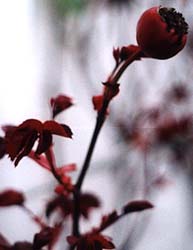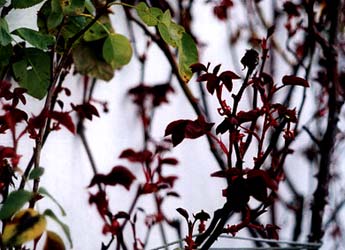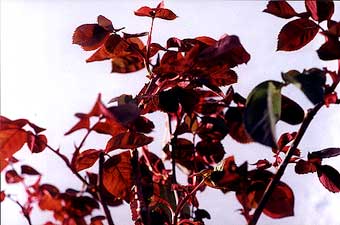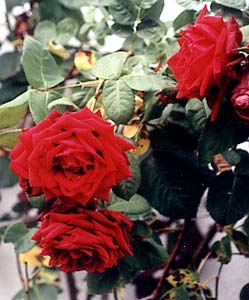 Brilliant Red Hips &
Brilliant Red Hips &
Late-Winter New Foliage on Our Porch Rose
"Some people are always grumbling
because roses have thorns.
I am thankful that thorns have roses."
-Alphonse Karr
(1808-1890)
(1808-1890)
This bright red rosehip was photographed in March 2002. There were several on the bush, as though a small child had taken red rubber balls from a jacks game to hang here & there among the thorny branches. The hips decorated the branches all winter long without losing their color. There could have been many more hips if we'd wanted, but we had been deadheading the bush to keep it blooming, so it set only a few of these fruits If we'd let more of the blooms finish their cycle, we might've had a hundred hips. For don't forget the Rose & the Apple Tree are related, & these hips might just as well have been called Rose Apples. They're not always round & red like this rose's hips though, some look more like brown footballs, some are even furry, & "apple" wouldn't describe all the sundry types of hips various roses produce.
We failed to experiment with them this past year & just left the hips as decorations, but they are edible, very rich in Vitamin C & harvestable for use in teas or jams & as a vitamin enriching ingredient for dehydrated fruit-leathers.
 As a soup, pie, or jelly flavoring, the rougher bits will need to be gotten rid of by extracting the juice. This is done by simmering one cup of hips in three cups of water ten or fifteen minutes in a pan of water (do not boil vigorously). Strain, then empty the sieve back onto the stove, add a tiny bit of water, simmer four minutes, strain again; & maybe one more time on the stove to get the very last of the useable pulp out of the seeds & skins. Or, for sundry soups, halved hips can be put in pierced stainless steel tea balls, along with hard spices such as star anise or cinnamon bark & whole cloves or bay leaves; the flavoring is particularly good in borscht. The spent teaballs can be emptied into the compost when the soup is done, leaving none of the woody hard bits in the soup, but wasting nothing.
As a soup, pie, or jelly flavoring, the rougher bits will need to be gotten rid of by extracting the juice. This is done by simmering one cup of hips in three cups of water ten or fifteen minutes in a pan of water (do not boil vigorously). Strain, then empty the sieve back onto the stove, add a tiny bit of water, simmer four minutes, strain again; & maybe one more time on the stove to get the very last of the useable pulp out of the seeds & skins. Or, for sundry soups, halved hips can be put in pierced stainless steel tea balls, along with hard spices such as star anise or cinnamon bark & whole cloves or bay leaves; the flavoring is particularly good in borscht. The spent teaballs can be emptied into the compost when the soup is done, leaving none of the woody hard bits in the soup, but wasting nothing. Only organic gardeners should use hips from the garden. If you're foolishly not an organic gardener but want to harvest hips for the kitchen even so, at least make sure any chemical treatments you use are safe for food crops.
The best time to harvest the hips would be soon after late autumn's or early winter's second good hard frost. A couple cold spells causes them to sweeten up. Before use in teas & soups, they can be split open & the seeds removed. These will grow if planted, but what sort of rose grows from a hip is unpredictable.
 I didn't initially take kindly to this rose. It came with the house. It was all stickery & neglected with a mean streak, always grabbing me & trying to do me harm. Its leaves were sickly, spotty, & brown. The whole bush seemed to be falling over. Granny Artemis decided to go to town on it & would regularly pluck off blighted leaves to toss in the trash, clipped back the vicious bits that had reached way out in the yard, & tied it back up against the sunny wall (we may yet slip an espalier trellis behind it but at present it is bound to the wall with a thin rope). We treated it to rose fertilizer too, which it probably hadn't had for many a year.
I didn't initially take kindly to this rose. It came with the house. It was all stickery & neglected with a mean streak, always grabbing me & trying to do me harm. Its leaves were sickly, spotty, & brown. The whole bush seemed to be falling over. Granny Artemis decided to go to town on it & would regularly pluck off blighted leaves to toss in the trash, clipped back the vicious bits that had reached way out in the yard, & tied it back up against the sunny wall (we may yet slip an espalier trellis behind it but at present it is bound to the wall with a thin rope). We treated it to rose fertilizer too, which it probably hadn't had for many a year.Our second year in this house, the Porch Rose bloomed most stunningly in response to Granny Artemis's arduous attentions, & a hazardous plant was transformed into a marvel of huge red blooms. We will never know what variety of a thousand possibilities it is, but it has gone from being That Damned Sticker By The Front Door, to the more honorific title of Our Porch Rose.
 The once-sorry leaves after reliable plucking & destroying of the spotty ones, became healthier & healther with regrowth, cured without recourse to chemical treatments, just a labor-intensive dressing of the plant to make sure no sickly leaves stayed long on the branches or on the ground beneath the rose.
The once-sorry leaves after reliable plucking & destroying of the spotty ones, became healthier & healther with regrowth, cured without recourse to chemical treatments, just a labor-intensive dressing of the plant to make sure no sickly leaves stayed long on the branches or on the ground beneath the rose.It regrew healthy foliage rapidly & kept some of its green leaves throughout the winter, never quite dropping them all. Then in March (as shown in second photo), continuing through April (as shown in the third portrait), our porch rose began producing the most amazing bright red foliage, nearly as colorful as the summer flowers. These leaves slowly turn to green of course, but what a delight to get such vibrant leaf colors such as are usually associated with Autumn but in this case are a prelude to Spring, when its only green leaves were the ones that had lasted from the previous year.
It blooms all summer long & the last photo on this page was taken in July. Most people quite naturally grow roses for just such extraordinary blossoms, but I am much more fascinated by the hips, & if it had not been possible to get pretty foliage & interesting limb structure out of it as well, I would never have taken to it for the sake of blooms alone. People who hack back their roses so there is never anything to them except the blooms, I don't share the excitement.